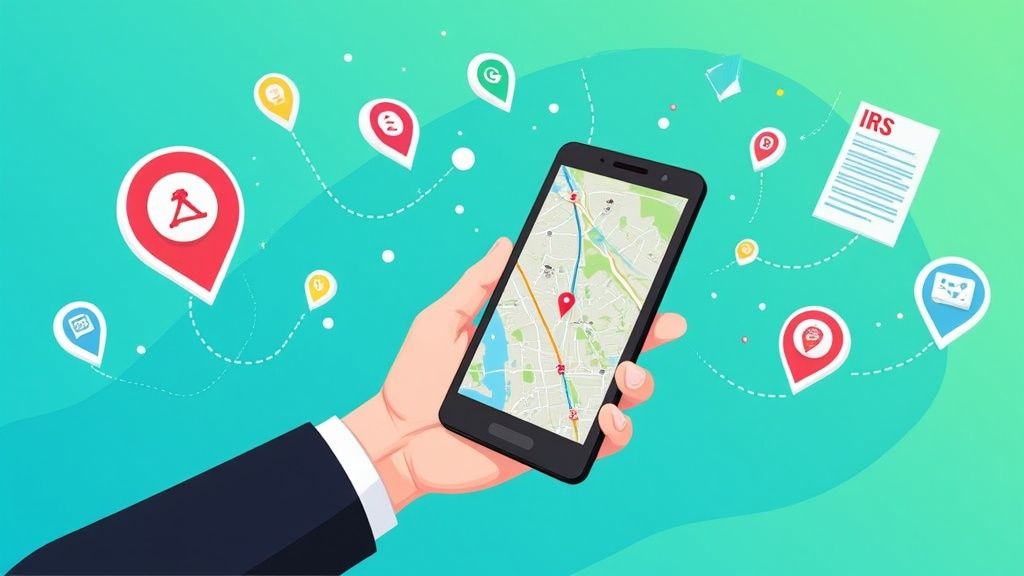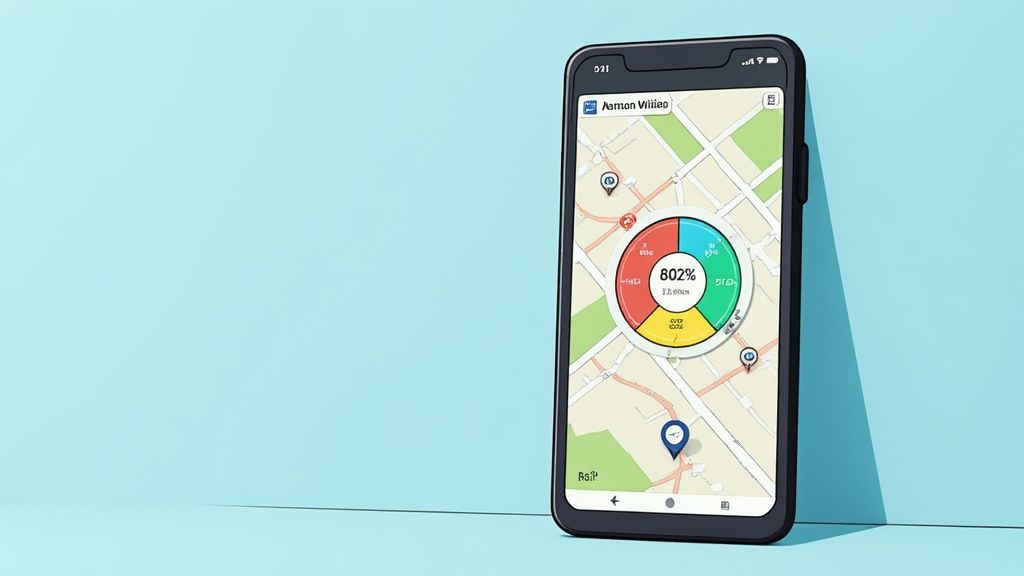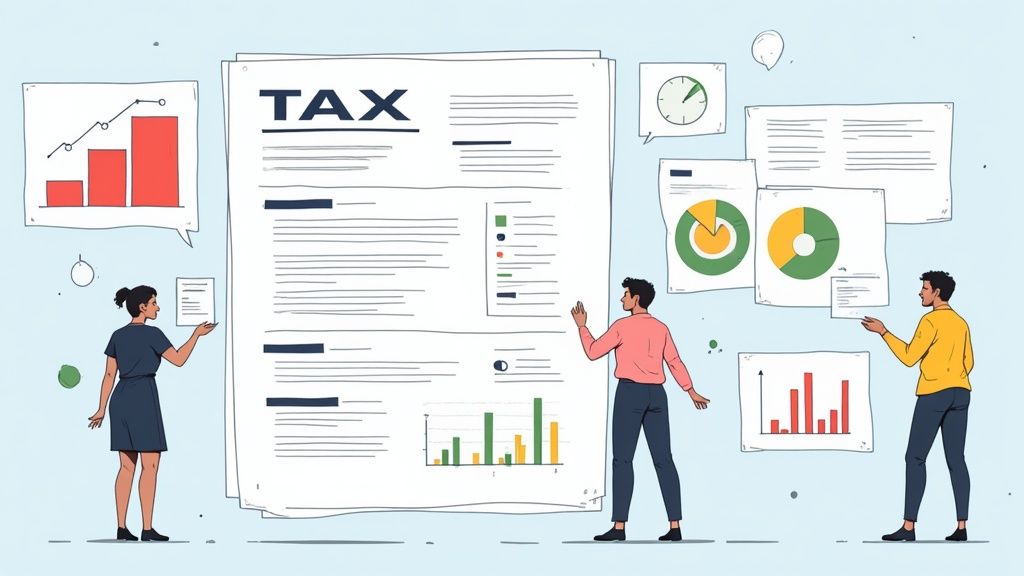
10 Best Apps to Track Mileage for Taxes: A Strategic Guide for Business Owners
Breaking Free from Manual Mileage Tracking

Are you still tracking business mileage with pen and paper or spreadsheets? These old-school methods drain valuable time and energy that could be better spent growing your business. Studies show that manual logging consumes around 20 hours per year - that’s nearly three full workdays spent on administrative busywork instead of revenue-generating activities. The good news is that there’s a better way. Let’s explore how switching to mileage tracking apps can save you time and maximize your tax deductions.
Why Ditch the Logbook?
Manual tracking creates several headaches beyond just wasting time. Paper logbooks are easy to misplace, calculation errors are common, and consistently logging every trip requires constant attention even for highly organized people. These issues often lead to missed deduction opportunities that directly impact your finances. For example, failing to claim just 1,000 business miles at the 2024 rate of 67 cents per mile means losing out on $670 in tax deductions. Over multiple years, those unclaimed miles can add up to thousands in lost savings. That’s why finding a more accurate and efficient tracking method is essential.
The Benefits of Using Apps to Track Mileage For Taxes
Modern mileage tracking apps offer an effective solution to the problems of manual logging. These apps use GPS to automatically record your trips, eliminating manual data entry and reducing human error. This means you can focus on your work while maintaining precise mileage records.
Here are the key advantages:
- Automated Tracking: GPS-based trip recording happens automatically in the background, saving time and improving accuracy
- IRS Compliance: Many apps generate IRS-ready reports, making tax preparation smoother and reducing audit risks
- Additional Features: Common extras include expense tracking, detailed reporting, and accounting software integration
- Maximizing Deductions: By capturing every eligible mile, these apps help you claim your full tax deductions and save hundreds or thousands annually
Making the Switch: From Manual to Automated
Transitioning to a mileage tracking app is straightforward. Most apps feature user-friendly designs and integrate smoothly with existing business tools. This means you can start benefiting from automated tracking quickly, without disrupting your normal workflow. By embracing this simple technology upgrade, you can eliminate the hassle of manual logging and dedicate more energy to what matters most – running and growing your business.
Navigating IRS Requirements With Confidence
Good record-keeping is essential for maximizing your mileage deductions while staying compliant with IRS requirements. While using mileage tracking apps offers clear advantages over manual methods, it’s important to understand exactly what documentation the IRS requires. This knowledge helps you claim all legitimate deductions with minimal audit risk.
Essential Trip Details: What the IRS Needs to Know
For each business trip, the IRS requires specific details to validate your deductions. Think of it as building your case - each data point strengthens your claim. Here are the key elements you need to track:
- Date: Record when each trip occurred to establish a clear timeline of business activities
- Starting and Ending Odometer Readings (for manual logs): Manual logs require recording odometer readings at the start and end of trips to document exact distances, while apps handle this automatically
- Purpose of the Trip: Be specific about why you made the trip. For instance, “Client meeting with ABC Corp to review project specs” is much better than just writing “Business trip”
- Destination: Note where you traveled to provide context for the business purpose, such as a customer’s office location or conference venue
Digital Tracking and IRS Compliance
Mileage tracking apps naturally align with IRS documentation requirements by automatically capturing trip details. This eliminates the human errors that often occur with manual logs, making your records more reliable during an audit. For example, MileIQ records dates, times and distances automatically to ensure accurate, consistent documentation.
Structuring Your Mileage Documentation for Maximum Deductions
Keeping your mileage records organized helps maximize deductions and simplifies tax preparation. Consider these common documentation methods:
| Documentation Method | Description | IRS Compliance |
|---|---|---|
| Mileage Tracking App | Automatically records trips using GPS. Generates IRS-ready reports. | Fully Compliant |
| Manual Logbook | Requires manual entry of trip details. Prone to errors. | Compliant if meticulously maintained |
| Spreadsheet | Can be used to organize manual logs. Requires careful data entry. | Compliant if accurate and complete |
For added support, keep receipts for fuel, tolls, and parking, especially if you deduct actual car expenses instead of using the standard mileage rate. This thorough approach ensures your records are organized and ready for review if needed.
Audit Survival: Real-World Examples and Lessons Learned
Well-organized mileage records can make a significant difference during an audit. Tax professionals often share stories of clients who avoided penalties simply because they maintained detailed documentation. On the flip side, poor record-keeping frequently leads to rejected deductions and potential fines. Using mileage tracking apps while following IRS guidelines creates strong documentation that protects your legitimate deductions. This shifts mileage tracking from a bothersome task to a valuable way to secure your business deductions and maintain financial stability.
Game-Changing Features Worth Your Investment

Modern mileage tracking apps do much more than just log your business miles. While meeting IRS requirements is essential, these apps now offer powerful features that make expense management simpler and help maximize your tax deductions. Let’s explore the key capabilities that make these tools invaluable for business owners.
Automated GPS Tracking: Your Silent Mileage Guardian
The convenience of automated GPS tracking has made manual mileage logs obsolete. This feature quietly works in the background, capturing every mile without any effort on your part. For a busy real estate agent rushing between property showings, not having to remember to log miles after each trip is a major time-saver. The automatic tracking ensures you never miss claiming a deductible mile, directly impacting your tax savings at year-end.
Real-Time Deduction Calculations: Clarity at Your Fingertips
Most mileage tracking apps now show you potential tax deductions as you drive, based on current IRS rates. This instant feedback helps you plan better and avoid surprises when tax season arrives. For example, seeing the deduction value after each client visit helps you evaluate if certain trips are worth the expense. This knowledge empowers smarter business decisions throughout the year.
Expense Integration and Reporting: The Power of a Unified System
Beyond basic mileage tracking, many apps let you record other vehicle costs like parking, tolls, and fuel. Some connect with QuickBooks or Xero accounting software, creating a complete financial picture in one place. This integration is especially helpful for companies managing multiple drivers or complex expense patterns. Having everything in a single system reduces data entry time and provides clear insights into travel spending trends.
Advanced Features for Enhanced Efficiency
Today’s mileage apps include specialized tools to match different business needs:
- Multi-Vehicle Management: Track mileage for multiple vehicles in one account - perfect for small fleets
- Trip Categorization: Label drives as business, personal, or charitable for accurate deduction claims
- Customizable Reporting: Create detailed reports by date, client, or project to analyze travel patterns
These advanced capabilities transform mileage tracking from a basic task into a valuable business tool. The right app choice means less stress during tax season and better financial outcomes for your business.
Maximizing Deductions Through Strategic App Usage

Smart use of mileage tracking apps can help you claim more tax deductions while staying compliant with IRS requirements. By going beyond basic mileage logging to take full advantage of available features, you can track every eligible expense and maintain detailed records that maximize your tax savings.
Advanced Categorization: The Key to Unlocking Hidden Deductions
Most mileage tracking apps let you label trips as business, personal, or charitable - a simple but powerful way to identify deductible miles. For example, when you drive to the post office for business mail followed by personal grocery shopping, proper categorization ensures you claim the business portion while excluding personal miles. This attention to detail helps you claim legitimate deductions with confidence during tax season.
Multi-Vehicle Management: Streamlining Deductions for Multiple Cars
For businesses using multiple vehicles or individuals who drive both personal and business cars, multi-vehicle tracking features are essential. These tools help you monitor mileage separately for each vehicle to capture every business mile. Take a freelancer who uses their own car for local client meetings but rents vehicles for longer business trips - tracking each vehicle independently creates clean, organized records ready for tax reporting.
Capturing Often-Overlooked Deductible Expenses: Parking, Tolls, and More
Business driving involves more than just mileage - parking fees at client sites, highway tolls during business travel, and vehicle maintenance costs (if using actual expenses instead of the standard rate) can all be tax-deductible. Many mileage apps include features to record these additional costs alongside your miles. A consultant who pays city parking fees for client meetings can log these expenses in their app to claim them at tax time.
Working With Current Mileage Rates: Maximizing Your Return
The IRS updates the standard mileage rate yearly - for 2024, it’s 67 cents per mile. This means driving 1,000 business miles lets you deduct $670. Quality apps automatically apply current rates to calculate your deductions and notify you of rate changes, helping you claim the right amount. This automatic tracking prevents calculation mistakes while ensuring you get the full value of your business miles.
Real-World Examples: Putting Strategies into Action
Consider how these features work together: A sales rep uses their app to categorize client visits, record parking costs, and calculate deductions at the current rate - capturing every valid expense for significant tax savings. Or take a small business owner managing delivery vehicles - the multi-vehicle tracking feature helps them monitor and claim deductions for their entire fleet efficiently.
By making full use of these app capabilities, you can turn routine mileage tracking into an effective tool for maximizing legitimate tax deductions while maintaining proper documentation for the IRS.
Creating a Seamless Financial Ecosystem
Smart financial management requires more than just logging miles. The key is connecting your mileage tracking data with your broader financial tools and systems. Think of it like a well-designed circuit - each component needs to integrate smoothly with the others to function properly. When you link your mileage app with accounting software, expense tools, and tax programs, you create an efficient system where data flows automatically between platforms.
Why Integration Matters for Your Business
Connecting your mileage tracking with other financial tools delivers clear benefits. Consider the alternative - manually copying mileage data from spreadsheets into accounting software each month, which wastes time and introduces errors. When your systems talk to each other automatically, that tedious data entry disappears. This frees up hours you can spend growing your business instead of doing administrative work. Having all your financial data in one connected system also makes it easier to spot trends and make informed decisions about spending.
Connecting Your Mileage Tracking App With Accounting Software
Leading mileage apps integrate seamlessly with popular accounting platforms like QuickBooks and Xero. This means your mileage records flow directly into your books without any manual steps. For example, with QuickBooks integration, your mileage expenses get automatically categorized and imported. The result is reliable, consistent records across all your systems.
Streamlining Expense Management and Tax Preparation
Beyond accounting, mileage apps can connect with expense management and tax preparation tools to further simplify your financial processes. When tax season arrives, your mileage data can import automatically into your tax software. This reduces data entry, prevents errors, and takes some stress out of tax filing. The more your tools work together, the smoother your financial management becomes.
Best Practices for Data Integration
While connecting your tools offers major advantages, follow these key practices to maintain accuracy and security:
- Choose Compatible Apps: Check that your tools are designed to work together. Most apps list their integration partners on their websites.
- Regularly Review Data: Even with automation, periodically verify that data matches across platforms.
- Secure Your Data: Use strong passwords and two-factor authentication to protect sensitive financial information.
- Seek Professional Guidance: When setting up integrations, consider consulting an accountant or IT expert.
Real-World Integration Examples
Consider a small business owner using MileIQ for mileage and QuickBooks for accounting. By connecting these tools, their mileage expenses flow automatically into their books. Or take a freelancer tracking miles in Hurdlr and importing that data directly to tax software at year-end. These real examples show how integrating mileage tracking with other financial tools saves time, reduces errors, and leads to better financial management. When mileage tracking becomes part of your broader system rather than a standalone task, the benefits multiply.
Building Your Mileage Tracking Strategy

Having covered the key features and benefits of mileage tracking apps, let’s create a practical plan to implement and maintain an effective tracking system. A well-designed strategy helps you select the right tools, set up reliable backups, and develop consistent tracking habits - all essential for capturing valuable tax deductions.
Choosing the Right App: A Personal Match
Finding the right mileage tracking app requires understanding your specific needs. A rideshare driver, for instance, has different requirements than a freelancer who makes occasional client visits. Some apps work best for managing multiple vehicles, while others focus on seamless accounting integration. Consider your daily routines and business goals when evaluating features like automated tracking, expense management, and reporting tools. This helps ensure you choose an app that genuinely supports your work.
Backup Systems: Securing Your Records
Even reliable technology can occasionally fail. Losing months of carefully tracked mileage data to a phone crash or app malfunction can be devastating. That’s why having backup systems is essential. Most quality apps include cloud storage that automatically saves your data to secure servers. As an extra precaution, regularly export your mileage reports as CSV or PDF files and store them separately. This two-layer approach keeps your records safe even if one system has issues.
Building Consistent Tracking Habits: Making It Second Nature
Even the best app won’t help if you don’t use it regularly. Create simple routines that make tracking part of your normal workflow. For example, take a few minutes at day’s end to review and categorize your trips. This prevents a backlog of unorganized data that becomes overwhelming to sort through later. Many apps let you create rules to automatically classify trips based on time or location. Think of mileage tracking like any essential business task - schedule it, make it a priority, and stick to the routine.
Training Your Team (If Applicable): Creating Shared Standards
For businesses with multiple drivers, consistent tracking across the team is vital for maximizing deductions. Create clear training materials that show employees how to use the chosen app effectively. Help everyone understand why accurate tracking matters and what procedures to follow. Check in regularly to answer questions and address any tracking challenges. This investment in training pays off through better compliance, accurate records, and optimal tax savings.
Review and Refine: Growing with Your Business
As your business evolves, so will your mileage tracking needs. Regularly evaluate your system to ensure it still serves your purposes. You might need to switch to an app with fleet management features as you add vehicles. Or you may want better integration with new accounting software to streamline your processes. Ongoing assessment helps maintain an efficient tracking strategy that continues supporting your business goals.
Ready to simplify your mileage tracking and maximize your tax deductions? Auto Service Logger provides a complete solution for managing vehicle maintenance records, including mileage tracking. Its easy-to-use interface, customizable reports, and secure data storage make it perfect for both individual vehicle owners and businesses. Start your journey towards stress-free mileage tracking and confident tax preparation. Check out Auto Service Logger today: https://autoservicelogger.com/